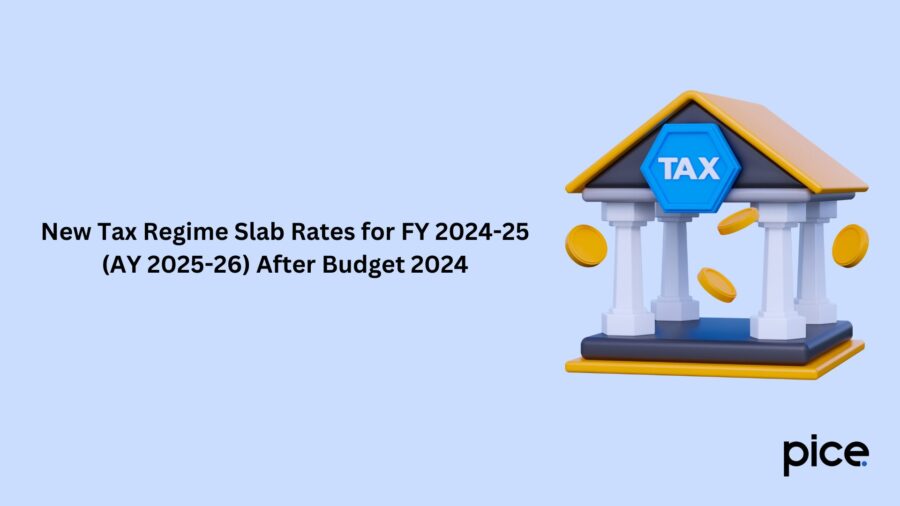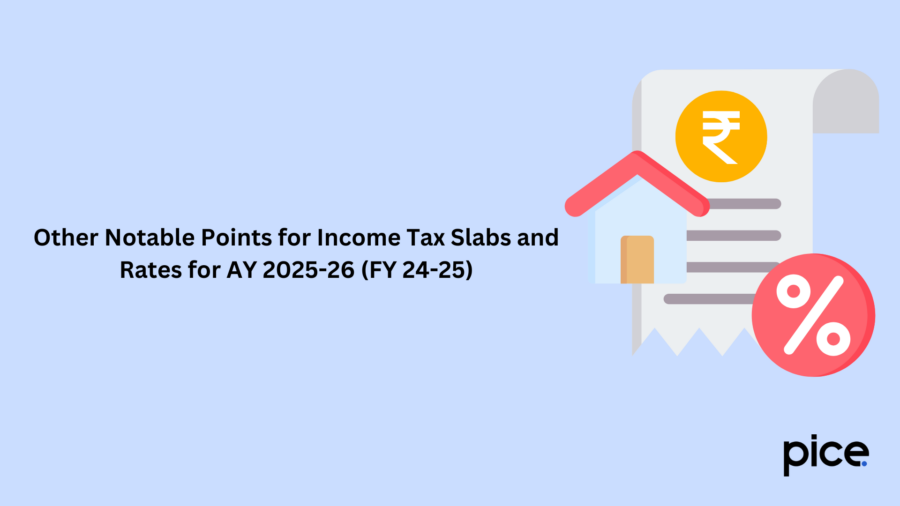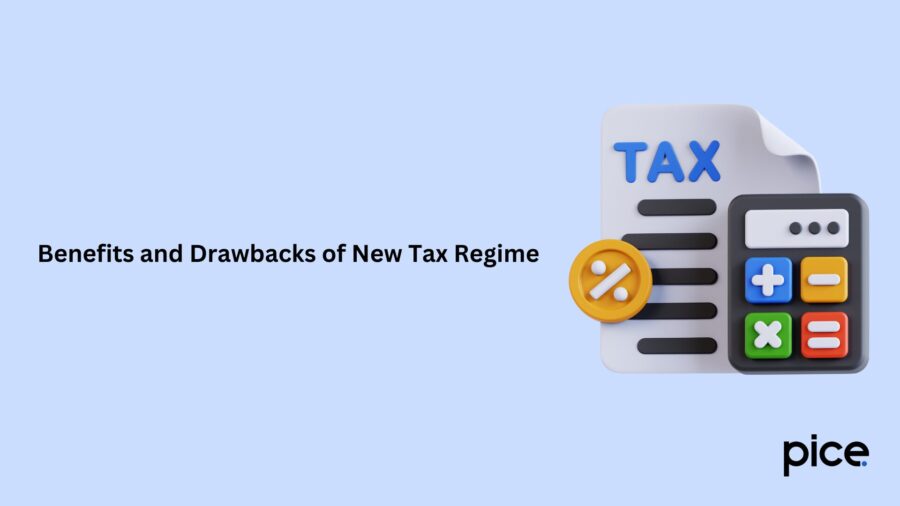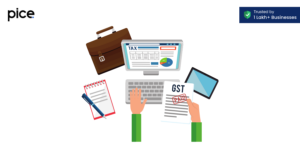Income Tax Slab for AY 2025-26
- 10 Feb 25
- 16 mins

Income Tax Slab for AY 2025-26
- Latest News on Income Tax Slabs in India (as of February 1, 2025)
- Tax Savings Breakdown Under the New Regime
- Upcoming Changes & Policy Announcements
- What Is an Income Tax Slab?
- New Tax Regime Slab Rates for FY 2024-25 (AY 2025-26) After Budget 2024
- Budget 2025: Reimagining the New Income Tax regime
- Income Tax Slabs and Rates for Financial Year 2024-25 Under the Old Tax Regime
- Old Tax Regime Vs New Tax Regime: FY 2024-25 (AY 2025-26) vs. FY 2023-24 (AY 2024-25)
- Other Notable Points for Income Tax Slabs and Rates for AY 2025-26 (FY 24-25)
- Exemptions and Deductions Allowed Under the New Tax Regime
- Exemptions and Deductions Not Available Under the New Tax Regime
- Benefits and Drawbacks of New Tax Regime
- Conclusion
Key Takeaways
- No tax for income up to ₹12 lakh under the new regime.
- Revised slabs ensure lower tax rates and higher savings.
- Senior citizens get a ₹1 lakh tax deduction benefit.
- The new regime simplifies filing but removes key deductions.
- Compare regimes to maximize tax savings efficiently.
Knowing the income tax slab for AY 2025-26 & 2026-27 is essential for every individual taxpayer to plan their finances effectively. Each year, the government revises the income tax slabs of India, which directly affect how much tax individuals and businesses must pay. Financial planning requires your attention because these modifications create substantial effects on your financial strategy.
The tax slabs for the assessment years 2025-26 & 2026-27 must be known in detail to correctly determine your tax responsibilities. Different tax-saving decisions become easier to understand while adhering to the most recent tax regulations.
Latest News on Income Tax Slabs in India (as of February 1, 2025)

On Saturday, February 1, 2025, Finance Minister Nirmala Sitharaman revealed that under the revised income tax regime, individuals with an annual income of up to ₹12 lakh will now be exempted from paying income tax. The new threshold stands higher than the preceding limit of ₹7 lakh.
Economic expansion can be stimulated through middle-class household growth of disposable income from this change in taxation structure.
The new tax system now provides a tax exemption of ₹4 lakh to lower-income citizens reflecting an upward trend in living costs. The elevated threshold ensures that fewer taxpayers need to file returns so they can experience decreased compliance requirements.
According to the new tax system, the existing deduction options face no modification. The standard tax deduction that employees can claim from their salary income amounts to ₹75,000 while their employers must contribute 14% of basic salary to National Pension System (NPS) Tier-I accounts.
The new tax regime allows salaried workers to maintain two crucial tax benefits through a combination of standard deductions and National Pension System employer contributions.
Revised Income Tax Slabs (New Regime—2025)
The following table shows the applicable income tax slabs for 2025-26:
| Income Tax Slabs | Tax Rates |
| Up to ₹4,00,000 | NIL |
| ₹4,00,001 to ₹8,00,000 | 5% |
| ₹8,00,001 to ₹12,00,000 | 10% |
| ₹12,00,001 to ₹16,00,000 | 15% |
| ₹16,00,001 to ₹20,00,000 | 20% |
| ₹20,00,001 to ₹24,00,000 | 25% |
| Above ₹24,00,000 | 30% |
Moreover, the tax deduction limit for senior citizens has been increased from ₹50,000 to ₹1 lakh, offering additional relief to elderly taxpayers.
The Finance Minister noted that these tax changes would lead to a loss of ₹1 lakh crore in direct tax revenue and ₹2,600 crore in indirect taxes for the government.
Tax Savings Breakdown Under the New Regime
The following shows the breakdown of tax savings under the new regime:
Existing Tax Savings
| Income Bracket | Tax Savings |
| ₹3,00,000 to ₹7,00,000 | ₹20,000 |
| ₹7,00,000to ₹10,00,000 | ₹30,000 |
| ₹10,00,000 to ₹12,00,000 | ₹30,000 |
| ₹12,00,000 to ₹15,00,000 | ₹60,000 |
| Total Tax | ₹1,40,000 |
Proposed Tax Savings
| Income Bracket | Tax Savings |
| ₹4,00,000 to ₹8,00,000 | ₹20,000 |
| ₹8,00,000 to ₹12,00,000 | ₹40,000 |
| ₹12,00,000 to ₹15,00,000 | ₹45,000 |
| Total Tax | ₹1,05,000 |
Net Tax Savings: Those earning ₹15 lakh annually will see a reduction of ₹35,000 in their taxes, even without the Section 87A rebate.
Upcoming Changes & Policy Announcements

Next week, the Income Tax Bill will be introduced by the government in order to advance Nyay (justice) through Bharatiya Nyay Sanhita principles. The Tax Deduction at Source (TDS) system will be streamlined to ease compliance for individual taxpayers. The finance minister highlighted that reforms are ongoing efforts toward achieving effective governance and economic growth.
Official Statement from FM Office
A tweet from the Finance Minister's office outlined the main points:
- Zero income tax for income up to ₹12 lakh under the new tax regime.
- Tax slabs and rates have been revised to benefit all eligible taxpayers.
- The new structure significantly reduces the tax burden on the middle class, leaving more disposable income for consumption, savings, and investment.
- The NIL tax slab is extended up to ₹12.75 lakh for salaried taxpayers, considering a standard deduction of ₹75,000.
What Is an Income Tax Slab?
Indian individuals must pay income tax through the income tax slab structure defined by their revenue level. Every stone on the chart depicts an individual tax percentage that increases with rising personal income.
The governmental planners developed this system to establish uniform taxation across every nation. Changes to the income tax slabs are usually introduced during the annual budget announcements. Income tax is divided into three age-based categories:
- Individuals under 60 years of age,
- Senior citizens between 60 and 80 years,
- Super senior citizens over 80 years
New Tax Regime Slab Rates for FY 2024-25 (AY 2025-26) After Budget 2024

The following table shows the new tax regime slab rates for FY 2024-25 (AY 2025-26) after budget 2024:
| Annual Taxable Income Slabs | New Tax Regime Slab Rates FY 24-25 (AY 25-26) | New Tax Regime Slab Rates FY 23-24 (AY 24-25) |
| Up to ₹3,00,000 | NIL | NIL |
| From ₹3,00,001 to ₹6,00,000 | 5% on income more than ₹3,00,000 | 5% on income more than ₹3,00,000 |
| From ₹6,00,001 to ₹7,00,000 | 5% on income more than ₹3,00,000 | 15,000 + 10% on income more than ₹6,00,000 |
| From ₹7,00,001 to ₹9,00,000 | 20,000 + 10% on income more than ₹7,00,000 | 25,000 + 10% on income more than ₹7,00,000 |
| From ₹9,00,001 to ₹10,00,000 | ₹20,000 + 10% on income more than ₹7,00,000 | ₹45,000 + 10% on income more than ₹9,00,000 |
| From ₹10,00,001 to ₹12,00,000 | ₹50,000 + 15% on income more than ₹10,00,000 | ₹55,000 + 15% on income more than ₹10,00,000 |
| From ₹12,00,001 to ₹15,00,000 | ₹80,000 + 20% on income more than ₹12,00,000 | ₹90,000 + 20% on income more than ₹12,00,000 |
| Above ₹15,00,000 | ₹1,40,000 + 30% on income more than ₹15,00,000 | ₹1,50,000 + 30% on income more than ₹15,00,000 |
Budget 2025: Reimagining the New Income Tax regime
The Union Budget 2025 is expected to introduce major tax reforms, with the government planning to replace the existing Income Tax Act, 1961, with a new Direct Tax Code. This initiative aims to simplify the tax system, reduce legal disputes, and improve compliance.
While the new tax regime introduced in 2021 has streamlined tax calculations, further refinements could promote financial discipline and ensure a fair distribution of tax liabilities.
Raising the 30% Tax Slab Threshold
Since 2020, the 30% tax slab threshold has remained unchanged, even as inflation has eroded its real value. Increasing this limit from ₹15 lakh to ₹18 lakh would prevent middle-class taxpayers from reaching the highest tax bracket too soon. This adjustment would create a more balanced tax structure.
Enhancing Tax Brackets
People are increasingly supporting an increase of the tax-free income threshold to ₹10 lakh. Evaluating tax rates as a whole system becomes critical because it helps avoid excessive burden on tax-paying individuals. Total income tax contributions primarily come from a minimal taxpayer segment, which requires a distribution method to create equity among all members.
Budget 2025 Could Consider
- Increasing the Rebate Under Section 87A: Raising the current ₹7 lakh limit under the new tax regime to ₹10 lakh would offer significant relief to taxpayers.
- Expanding Income Tax Slabs: Reducing the sharp jumps in tax rates, particularly in the old tax regime, would make it more competitive with the new regime.
- Raising the Standard Deduction: Increasing it to ₹75,000 under the new regime would provide salaried individuals with greater financial relief.
- Aligning tax slabs across regimes: Creating uniform tax slabs and rates in both regimes would improve consistency and simplify tax planning.
Reintroducing Deductions
Tax-related income deductions created in the recent period drove down long-term savings and investment in life insurance products, ELSS, and small savings schemes. To counter this, the government could introduce a flat deduction of 30% on gross income, capped at ₹15 lakh. This would encourage investments in essential expenses, insurance, and long-term wealth creation while maintaining tax equity across income groups.
By implementing these measures, Budget 2025 can establish a fairer and more progressive tax system that promotes savings, expands financial inclusion, and supports economic growth.
Income Tax Slabs and Rates for Financial Year 2024-25 Under the Old Tax Regime
The below table shows the income tax slabs and rates for the financial year 2024-25 under the old tax regime:
| Category | Income Range | Tax Rate |
| Individuals below 60 years, HUFs, BOIs, AoPs | Up to ₹2,50,000 | NIL |
| ₹2,50,000 to ₹5,00,000 | Up to 5% | |
| ₹5,00,000 to ₹10,00,000 | 20% | |
| Above ₹10,00,000 | 30% | |
| Senior citizens (60 to 80 years) | Up to ₹3,00,000 | NIL |
| ₹3,00,000 to ₹5,00,000 | Up to 5% | |
| ₹5,00,000 to ₹10,00,000 | 20% | |
| Above ₹10,00,000 | 30% | |
| Super senior citizens (80+ years) | Up to ₹5,00,000 | NIL |
| ₹5,00,000 to ₹10,00,000 | 20% | |
| Above ₹10,00,000 | 30% |
Old Tax Regime Vs New Tax Regime: FY 2024-25 (AY 2025-26) vs. FY 2023-24 (AY 2024-25)
The new tax regime was the standard tax regime for individual taxpayers from the financial year 2024-25. While this regime provides fewer rebates for taxpayers compared to the previous regime, the government allows taxpayers to select between the new and old regimes according to their preference.
A comparison of the new tax regime’s slab rates for FY 2024-25 (AY 2025-26) against those for FY 2023-24 (AY 2024-25) shows that the updated regime offers more tax relief, making it a more attractive option for many. Below is a detailed breakdown of the income tax slab rates for both years under the new regime.
| Old Tax Regime | New Tax Regime | ||||
| Income Tax Slab | Income Tax Rate | *Surcharge | Income Tax Slab | Income Tax Rate | *Surcharge |
| Up to ₹2,50,000 | NIL | NIL | Up to ₹3,00,000 | NIL | NIL |
| ₹2,50,001 to ₹5,00,000 | 5% above ₹2,50,000 | NIL | ₹3,00,001 to ₹7,00,000 | 5% above ₹3,00,000 | NIL |
| ₹5,00,001 to ₹10,00,000 | ₹12,500 + 20% above ₹5,00,000 | NIL | ₹7,00,001 to ₹10,00,000 | ₹20,000 + 10% above ₹7,00,000 | NIL |
| ₹10,00,001 to ₹50,00,000 | ₹1,12,500 + 30% above ₹10,00,000 | NIL | ₹10,00,001 to ₹12,00,000 | ₹50,000 + 15% above ₹10,00,000 | NIL |
| ₹50,00,001 to ₹1,00,00,000 | ₹1,12,500 + 30% above ₹10,00,000 | 10% | ₹12,00,001 to ₹15,00,000 | ₹80,000 + 20% above ₹12,00,000 | NIL |
| ₹1,00,00,001 to ₹2,00,00,000 | ₹1,12,500 + 30% above ₹10,00,000 | 15% | ₹15,00,001 to ₹50,00,000 | ₹1,40,000 + 30% above ₹15,00,000 | NIL |
| ₹2,00,00,001 to ₹5,00,00,000 | ₹1,12,500 + 30% above ₹10,00,000 | 25% | ₹50,00,001 to ₹100,00,000 | ₹1,40,000 + 30% above ₹15,00,000 | 10% |
| Above ₹500,00,000 | ₹1,12,500 + 30% above ₹10,00,000 | 37% | ₹1,00,00,001 to ₹200,00,000 | ₹1,40,000 + 30% above ₹15,00,000 | 15% |
| Above ₹200,00,001 | ₹1,40,000 + 30% above ₹15,00,000 | 25% | |||
The Interim Budget 2024-25 first retained the income tax structure and the rates prevalent for the previous year for the Assessment Year 2025-26. However, the full Budget 2024 has added changes whereby the new tax rates have become the standard regime for everybody, including companies, HUFs, and other corporations. While taxpayers still have the flexibility to opt for the old regime, which includes tax deductions and basic exemption limits, the new regime features revised tax slabs and rates.
For eligible taxpayers earning income from business and profession, the new tax regime is the default option. If an assessee wants to opt out, they have to file Form 10-IEA before the due date mentioned in section 139(1) for filing of income tax return.
As is the case with withdrawing from the previous taxation system and adopting the new one, the Form 10-IEA is the one to be filled out as well. However, taxpayers with business and professional income can switch back to the old tax regime and revoke this choice only once in their lifetime.
Other Notable Points for Income Tax Slabs and Rates for AY 2025-26 (FY 24-25)

Here are some notable points for income tax slabs and rates for the AY 2025-26:
- Surcharge and Cess
A 4% health and education cess is imposed on the total tax payable. Additionally, a surcharge applies to incomes exceeding ₹50 lakh in FY 2024-25, based on specified rates. The following table mentions the rate of surcharge on income tax under the old and new income tax regimes:
| Annual Taxable Income | Surcharge on Income Tax (Old Tax Regime) | Surcharge on Income Tax (New Tax Regime) |
| Till ₹50,00,000 | NIL | NIL |
| Over ₹50,00,000 and up to ₹1 crore | 10% | 10% |
| Over ₹1 crore and up to ₹2 crore | 15% | 15% |
| Over ₹2 crore and up to ₹5 crore | 25% | 25% |
| Over ₹5 crore | 37% | 25% |
The highest surcharge under the new tax regime is limited to 25%, while under the old tax regime for AY 2025-26, it can go up to 37%. These enhanced surcharge rates of 25% and 37% do not apply to income taxed under sections 111A, 112, 112A, and dividend income
2. Uniform Tax Slabs for All
Currently, there is no difference that has been made between men and women in terms of tax slabs or tax rates, hence fair taxation for both sexes.
3. Tax Rebate Eligibility
The following is the tax rebate eligibility:
- Old Tax Regime: For individuals and Hindu Undivided Families (HUFs), as far as FY 2024-25 is concerned, if the total taxable income does not exceed ₹5 lakh, then as per Section 87A, he/she is eligible for a rebate of up to ₹ 12,500.
- New Tax Regime: Individuals having a taxable income up to ₹7 lakhs are entitled to receive full tax rebate u/s 87A.
According to the proposed Finance Bill 2025, the rebate under Section 87A is now applicable to individuals with a total income of up to ₹12 lakh. This enables taxpayers to receive a rebate of up to ₹60,000 on their tax liability.
With the new provisions, if the tax payable is ₹60,000 or less for an income of ₹12 lakh or below, individuals can utilize the rebate, reducing their overall tax liability to zero.
Exemptions and Deductions Allowed Under the New Tax Regime
Under the new tax regime, the following exemptions and deductions are available:
Salary-Related Exemptions:
- Transport allowance for specially-abled individuals
- Conveyance allowance for expenses incurred during employment
- Compensation received for travel costs related to tours or transfers
- Daily allowance to cover routine expenses due to absence from the regular workplace
- Perquisites used for official purposes
- Exemptions on voluntary retirement benefits (Section 10(10C)), gratuity (Section 10(10)), and leave encashment (Section 10(10AA))
- A standard deduction of ₹50,000 introduced in Budget 2023, which was increased to ₹75,000 in Budget 2024 (effective from FY 2024-25)
House Property:
- Interest on home loans for let-out properties (Section 24)
Other Sources of Income:
- Gifts up to ₹50,000
- Deduction under Section 57(iia) for family pension income, with the maximum limit raised from ₹15,000 to ₹25,000 in Budget 2024
Chapter VI-A Deductions:
- Deduction for employer’s contribution to the NPS account (Section 80CCD(2)).
- Deduction for additional employee costs (Section 80JJA).
- Deduction under Section 80CCH(2) for amounts paid or deposited in the Agniveer Corpus Fund (introduced in Budget 2023).
- The limit for employer contributions to pension schemes under Section 80CCD(2) was increased from 10% to 14% of salary in Budget 2024.
Exemptions and Deductions Not Available Under the New Tax Regime
Under the new tax regime, several exemptions and deductions cannot be claimed. Here are some key exclusions:
Salary-Related Exemptions:
- Professional tax and entertainment allowance
- House Rent Allowance (HRA)
- Leave Travel Allowance (LTA)
- Allowances for MLAs or MPs
- Children’s education allowance
- Helper allowance
- Other special allowances under Section 10(14)
House Property:
- Interest on home loans for self-occupied or vacant properties (Section 24)
Other Sources of Income:
- Minor child income allowance
Business or Profession:
- Deductions under Section 35AD and Section 35CCC
- Additional depreciation under Section 32(1)(iia)
- Deductions under Sections 32AD, 33AB, and 33ABA
- Deductions for donations or expenses related to scientific research under Sections 35(2AA), 35(1)(ii), (iia), or (iii)
- Exemption for SEZ units under Section 10AA
Chapter VI-A Deductions:
- Deductions under Sections 80TTA/80TTB (Savings and deposit interest)
- Sections 80C, 80D, and 80E, except for Sections 80CCD(2) and 80JJAA
- Exemption for perquisites or allowances, including meal allowance (₹50 per meal, up to two meals per day)
- Employee’s own contribution to NPS
- Donations to trusts or political parties
Benefits and Drawbacks of New Tax Regime

Deciding between India’s new and old tax regimes requires assessing their pros and cons based on your income, spending habits, and investment approach. Here is a comparison to help you choose wisely:
Advantages of the New Tax Regime
The following are the advantages of the new tax regime:
- Easier Tax Filing: With fewer tax deductions and exemptions, the new regime simplifies income tax calculations, making it ideal for those who find the old system too complex.
- Tax Rebate and Lower Tax Rates: Under the new tax regime, individuals with earnings up to ₹12 lakh will pay no tax. Additionally, those earning above ₹12 lakh will enjoy reduced tax rates compared to the old tax regime.
- Greater Cash Availability: Tax-saving investments exist voluntarily, which offers you improved flexibility to direct your funds towards specific needs.
Limitations of the New Tax Regime
The following are some limitations of the new tax regime:
- No Deductions and Exemptions: Under the new tax system you must waive out all deductions including HRA and LTA and 80C deductions which might elevate your taxable amount.
- Reduced Tax Planning Freedom: The freedom in this case is reduced due to a lack of options when deductions are no longer available as investors have no other technique to reduce tax through planned investment and expenses.
- Hike in the Cost Impacting the Policy: The imposition of the surcharges is likely to affect people earning more than ₹10 lakhs because they shall be subjected to increased tax levies once their incomes go beyond ₹5 crores.
- Not Ideal for Long-Term Investors: The new tax system does not provide any favourable treatment for investors who depend on tax-saving schemes to build wealth thus making it less appealing to retain.
Key Factors to Consider
Here are some key factors you need to consider before choosing between the old and new tax regimes to file an income tax return:
- Switching Between Regimes: People who file annual income tax return have the option to use either the old or new tax system according to their financial goals.
- Compare Before Choosing: Income tax calculators should be used for comparing tax regimes to determine which method produces the lowest tax obligation.
- Think Long-Term: Future income development alongside saved money and investments should be your main focus when deciding between tax systems.
- Seek Expert Guidance: A tax consultant can help you develop a tax-efficient strategy tailored to your financial situation.
Conclusion
Keeping track of the income tax slab for AY 2025-26 & AY 2026-27 is a smart strategy for managing your finances. The revised tax slabs can impact your overall tax burden, but by staying updated, you can plan better, optimise deductions, and ensure that you do not miss out on any savings opportunities.
This knowledge empowers you to make informed decisions and allows you to navigate the complexities of income tax more easily. In the end, understanding these changes can help you reduce your tax liability and contribute to a more secure financial future.
💡If you want to streamline your payment and make GST payments via credit card, consider using the PICE App. Explore the PICE App today and take your business to new heights.
 By
By 
















